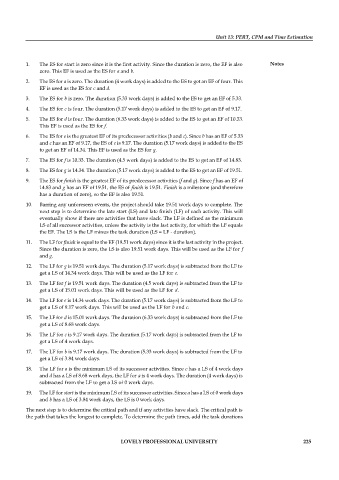Page 230 - DMGT521_PROJECT_MANAGEMENT
P. 230
Unit 13: PERT, CPM and Time Estimation
1. The ES for start is zero since it is the first activity. Since the duration is zero, the EF is also Notes
zero. This EF is used as the ES for a and b.
2. The ES for a is zero. The duration (4 work days) is added to the ES to get an EF of four. This
EF is used as the ES for c and d.
3. The ES for b is zero. The duration (5.33 work days) is added to the ES to get an EF of 5.33.
4. The ES for c is four. The duration (5.17 work days) is added to the ES to get an EF of 9.17.
5. The ES for d is four. The duration (6.33 work days) is added to the ES to get an EF of 10.33.
This EF is used as the ES for f.
6. The ES for e is the greatest EF of its predecessor activities (b and c). Since b has an EF of 5.33
and c has an EF of 9.17, the ES of e is 9.17. The duration (5.17 work days) is added to the ES
to get an EF of 14.34. This EF is used as the ES for g.
7. The ES for f is 10.33. The duration (4.5 work days) is added to the ES to get an EF of 14.83.
8. The ES for g is 14.34. The duration (5.17 work days) is added to the ES to get an EF of 19.51.
9. The ES for finish is the greatest EF of its predecessor activities (f and g). Since f has an EF of
14.83 and g has an EF of 19.51, the ES of finish is 19.51. Finish is a milestone (and therefore
has a duration of zero), so the EF is also 19.51.
10. Barring any unforeseen events, the project should take 19.51 work days to complete. The
next step is to determine the late start (LS) and late finish (LF) of each activity. This will
eventually show if there are activities that have slack. The LF is defined as the minimum
LS of all successor activities, unless the activity is the last activity, for which the LF equals
the EF. The LS is the LF minus the task duration (LS = LF - duration).
11. The LF for finish is equal to the EF (19.51 work days) since it is the last activity in the project.
Since the duration is zero, the LS is also 19.51 work days. This will be used as the LF for f
and g.
12. The LF for g is 19.51 work days. The duration (5.17 work days) is subtracted from the LF to
get a LS of 14.34 work days. This will be used as the LF for e.
13. The LF for f is 19.51 work days. The duration (4.5 work days) is subtracted from the LF to
get a LS of 15.01 work days. This will be used as the LF for d.
14. The LF for e is 14.34 work days. The duration (5.17 work days) is subtracted from the LF to
get a LS of 9.17 work days. This will be used as the LF for b and c.
15. The LF for d is 15.01 work days. The duration (6.33 work days) is subtracted from the LF to
get a LS of 8.68 work days.
16. The LF for c is 9.17 work days. The duration (5.17 work days) is subtracted from the LF to
get a LS of 4 work days.
17. The LF for b is 9.17 work days. The duration (5.33 work days) is subtracted from the LF to
get a LS of 3.84 work days.
18. The LF for a is the minimum LS of its successor activities. Since c has a LS of 4 work days
and d has a LS of 8.68 work days, the LF for a is 4 work days. The duration (4 work days) is
subtracted from the LF to get a LS of 0 work days.
19. The LF for start is the minimum LS of its successor activities. Since a has a LS of 0 work days
and b has a LS of 3.84 work days, the LS is 0 work days.
The next step is to determine the critical path and if any activities have slack. The critical path is
the path that takes the longest to complete. To determine the path times, add the task durations
LOVELY PROFESSIONAL UNIVERSITY 225

